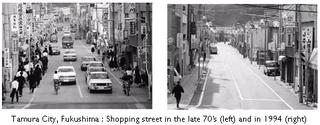Japan's Towns Say No to Big Retail
Japan’s small towns and regions are leading a backlash against suburban retail development. This month, Fukushima became the first prefecture to impose a permit system for new large stores - defined as over 6,000 sq.m. in store area - on top of the existing environmental and public-comment requirements (see this Asahi report). Other prefectures like Kumamoto, Iwate, Toyama, Shizuoka, and Okinawa are considering such measures. The moves follow a raft of similar legislation by individual municipalities across the country, pioneered by Aomori City in northern Japan.
The moves, which retailers have criticized as ‘short-sighted’ and ‘unconstitutional’, come five years after deregulation prompted a rush of new large stores in suburban areas. Urban planners in Japan, however, seem set to swing the pendulum back towards more stringent laws, in the midst of a growing movement for the revitalization of town centers (see also this Yomiuri column and my previous post on this). New revisions to the law are to be submitted to the Diet next year.
Japan’s rural communities are still mired in economic and demographic decline. Developments outside the towns have accelerated a hollowing-out of commercial activity from the traditional shopping districts in town centers, many of which are now pitiful zones of shuttered shops and deserted streets. In some places, even local governments have packed up and moved their offices to other areas, the result of either Bubble-era expansionary policies or a more recent wave of municipal mergers. Many large stores that were located in town centers quickly became unprofitable, and a large number have closed in recent years. Unable to attract new tenants, the shells of abandoned supermarkets, banks, and offices stand empty as if symbols of a bygone era.

It wasn't always this way. Deregulation of Japan’s retail laws in 2000, due largely to US pressure, made it relatively easier to open large stores on the outskirts of towns. Previously, permission from local trade associations, which was invariably dominated of small shopkeepers in the older parts of towns, was required. New laws freed large retailers from these political chains, and set more objective environmental review and public comment requirements. The new setup proved to be a cakewalk for the big retail firms, and a large number of new malls, power centers, big-box stores, and other new developments began to mushroom in the Japanese countryside. The trend was also helped by the gradual erosion of the traditional rigid wholesale structure, the increase in available land (due, among other factors, to the shift of manufacturing to China), and the devolution of planning powers to local communities. Revenue-hungry towns gladly effected zoning changes to agricultural land, making it easier for retail to locate in greenfield sites. The number of large stores has gone up 30% nationwide since 1997, and they have taken up an ever-larger slice of Japan’s total retail sales. More than 70% of new stores are now opened in suburban areas.
Related Links
Flath, David : The Large Store Law and Retail Density, 2002
Japan Retail Fund : Overview of the Retail Property Market in Japan, 2005
Jones Lang LaSalle : Japan’s Changing Retail Scene, 2005
Japan Real Estate Blog
Tags : japan, real estate, property, investment, 不動産
まちづくり3法 立地法 福島県 青森市 商業施設 大型店 規制

0 Comments:
Post a Comment
<< Home